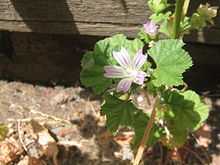Malva neglecta
From Wikipedia, the free encyclopedia
| Malva neglecta | |
|---|---|
 | |
| common mallow | |
| Scientific classification | |
| Kingdom: | Plantae |
| (unranked): | Angiosperms |
| (unranked): | Eudicots |
| (unranked): | Rosids |
| Order: | Malvales |
| Family: | Malvaceae |
| Genus: | Malva |
| Species: | M. neglecta |
| Binomial name | |
| Malva neglecta Wallr.[1] | |
| Synonyms | |
|
Malva rotundifolia auct. non L. | |
Malva neglecta is also known as Common mallow in the United States and also buttonweed, cheeseplant, cheeseweed, dwarf mallow and roundleaf mallow.[2] Although often considered a weed, this plant is often consumed as a food.[3][4][5] This is especially true of the seeds, which contain 21% protein and 15.2% fat.[6] The plant is an invasive in the United States. [7]
Distribution
- Native
- Palearctic:
- Macaronesia: Canary Islands
- Northern Africa: Algeria, Morocco
- Arabian Peninsula: Saudi Arabia
- Western Asia: Afghanistan, Cyprus, Sinai, Iran, Iraq, Israel, Jordan, Lebanon, Occupied Palestinian Territories, Syria, Turkey
- Caucasus: Armenia, Azerbaijan, Georgia
- Soviet Middle Asia: Kazakhstan, Kyrgyzstan, Tajikistan, Turkmenistan, Uzbekistan
- Mongolia: Mongolia
- China: Xinjiang
- Indian Subcontinent: India, Pakistan
- Northern Europe: Denmark, Ireland, Norway, Sweden, United Kingdom
- Middle Europe: Austria, Belgium, Czech Republic, Germany, Hungary, Netherlands, Poland, Slovakia, Switzerland
- Southeastern Europe: Albania, Bosnia and Herzegovina, Bulgaria, Croatia, Greece, Italy, Macedonia, Montenegro, Sardinia, Serbia, Slovenia, Romania,
- Southwestern Europe: France, Portugal, Spain
Source: [1]
Uses
Malva neglecta herb has been used in the traditional Austrian medicine internally as tea or externally as baths for treatment of disorders of the skin, gastrointestinal tract and respiratory tract.[8]
References
- ↑ 1.0 1.1 Germplasm Resources Information Network (GRIN) (1995-05-23). "Taxon: Malva neglecta Wallr.". Taxonomy for Plants. USDA, ARS, National Genetic Resources Program, National Germplasm Resources Laboratory, Beltsville, Maryland. Retrieved 2008-05-09.
- ↑ "Malva neglecta". Integrated Taxonomic Information System. Retrieved 9 May 2008.
- ↑ Facciola S. Cornucopia – A Source Book of Edible Plants. Vista, Ca. Kampong Publications, 1990. 677 p.
- ↑ http://www.youtube.com/watch?v=bdGAUejE8BM&feature=channel_page
- ↑ http://www.pfaf.org/database/plants.php?Malva+neglecta
- ↑ Duke JA. CRC Handbook of Proximate Analysis Tables of Higher Plants. Boca Raton, Fl. CRC Press, 1986. 389 p.
- ↑ Peterson, Roger Tory, and Margaret McKenny, A Field Guide to Wildflowers of Northeastern and North Central North America. 1968, p.32
- ↑ Vogl S, Picker P, Mihaly-Bison J, Fakhrudin N, Atanasov AG, Heiss EH, Wawrosch C, Reznicek G, Dirsch VM, Saukel J, Kopp B. Ethnopharmacological in vitro studies on Austria's folk medicine - An unexplored lore in vitro anti-inflammatory activities of 71 Austrian traditional herbal drugs. J Ethnopharmacol.2013 Jun13. doi:pii: S0378-8741(13)00410-8. 10.1016/j.jep.2013.06.007. [Epub ahead of print] PubMed PMID: 23770053. http://www.ncbi.nlm.nih.gov/pubmed/23770053
External links
![]() Media related to Malva neglecta at Wikimedia Commons
Media related to Malva neglecta at Wikimedia Commons
![]() Data related to Malva neglecta at Wikispecies
Data related to Malva neglecta at Wikispecies
- Natural Resources Conservation Service (NRCS). "PLANTS Profile, Malva neglecta". The PLANTS Database. United States Department of Agriculture. Retrieved 2008-05-09.
- UniProt. "Species Malva neglecta (Common mallow)". Retrieved 2008-05-09.
This article is issued from Wikipedia. The text is available under the Creative Commons Attribution/Share Alike; additional terms may apply for the media files.